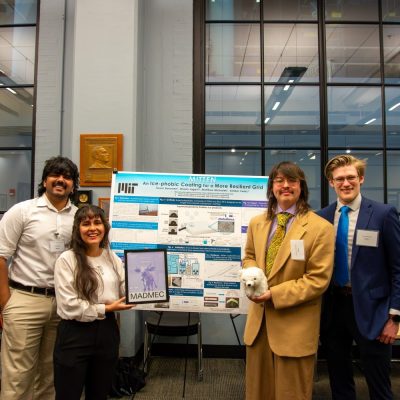
How different fonts hold up, literally: Structural optimization of I-beams via typographical analysis
On his award-winning YouTube channel Atomic Frontier, STAR Lab PhD student James Dingley finally answered a question he was asked three years ago: “Which typeface’s capital I makes the best I-beam?”
The question sparked a full-blown engineering investigation, culminating in the YouTube video and study: “Structural optimization of I-beams via typographical analysis: A comparative study of alphabetical cross-sections.” Co-authored with Prof. Kerri Cahoy, the study investigates the structural performance of capital letters from over 1,000 typefaces to determine their suitability for use as beam cross-sections under bending.
I-beams are a staple of structural engineering, prized for their efficiency in bearing loads by distributing compression and tension along their flanges and webs. Dingley’s approach was to actually construct and test I-beams representing multiple fonts.
Dingley conducted extensive simulation and physical testing in the MIT MakerWorkshop, with support from the MIT Hobby Shop. Each letter was cut from blocks of HDPE plastic using a four-axis CNC router. The study generated more than 13 terabytes of simulation data, which was distilled and evaluated. The project challenges long-standing assumptions about I-beam geometry and also demonstrates the potential for incorporating typographic diversity into functional structural elements.
The results? Ranking at the bottom, the calligraphic typeface “Zapfino” proved both a nightmare to produce and collapsed almost immediately. In contrast, Courier New held up under pressure, bending, buckling, and torsion. While some typefaces did outperform the standard I-beam in specific loading conditions, rotated capital H’s outperformed traditional I-beams.
In STAR Lab, Dingley’s research focuses on using robotics for space-based satellite assembly operations. The tools he used to simulate beam bending are also used to assess how robots will survive the violent loading conditions of a launch. “Actually, our current best-performing platform is a cartesian robot that’s basically just a bunch of beams stuck together. Although for that one we’re using Aluminum extrusion in a sort of x-profile rather than a traditional I-beam!” says Dingley. “Maybe our next version will look a bit more typographical.”
Authors: James Dingley and Kerri Cahoy
Citation: April 2025, Structural Optimization of I-Beams via Typographical Analysis: A Comparative Study of Alphabetical Cross-Sections
Abstract:
Recent advances in computational mechanics and manufacturing technologies have enabled the exploration of unconventional cross-sectional profiles in structural engineering. One such profile—long assumed to be optimal—is the I-beam, named after the capital letter “I” which its wide flanges and thin vertical webbing resemble. However, the typographic origin of this nomenclature remains unexamined in structural terms.
This study investigates the structural performance of capital letterforms from over 1,000 digital typefaces to determine their suitability for use as beam cross-sections under bending. A custom simulation pipeline employing finite element analysis was developed to automate mesh generation from typographic contours, with results normalized for beam mass to allow direct comparison. Experimental validation was conducted using physical beams machined from high-density polyethylene and tested on an Instron load frame. Simulated and real-world data revealed that several typefaces outperform the conventional Ibeam under specific loading conditions. Under observation that a rotated “H” also resembles an I-beam profile, additional analysis was conducted into the performance of not only this rotated “H” but also the rest of the alphabet. To reflect how I-beams are today employed in more than just simple bending, this full set was also examined in the buckling, tension, and torsion regimes. Notable results are that the (Courier New) typeface produces an I-beam that is most similar in form and appearance to a regular I-beam and (BioRhyme) performs slightly better due to the efficient removal of fillets in favor of wider flanges. Considering other letter-forms, rotated “H” profiles exhibited superior performance in both bending and torsion, while circular forms such as capital O provided the best resistance to buckling. In contrast, handwritten fonts such as (Zapfino) tend to fail prematurely, with letters such as J and L present insufficient cross sectional support.
This study not only challenges long-standing assumptions about I-beam geometry but also demonstrates the potential for incorporating typographic diversity into functional structural elements. All code, data, and analysis tools have been made publicly available to support future work in typographic engineering.

